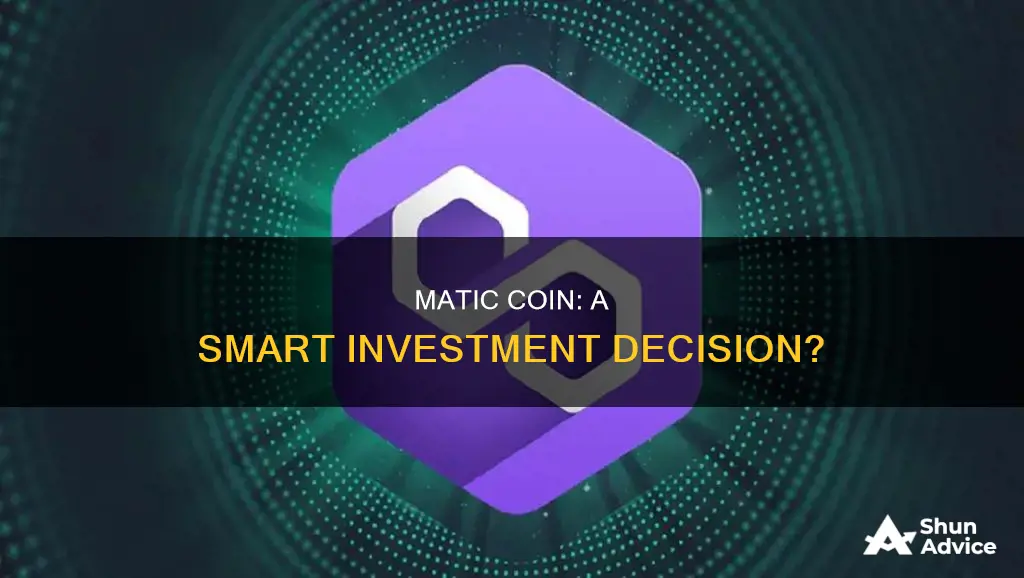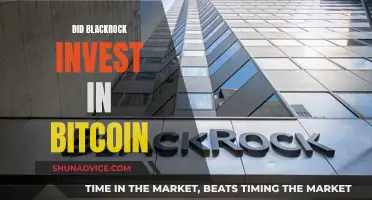
Matic is a cryptocurrency token that powers Polygon, a system that allows people to conduct business off the main Ethereum blockchain. It has been described as one of the most popular scaling solution protocols in the decentralised finance space. It was launched in October 2017 and has since seen substantial growth. In this article, we will explore whether Matic is a good investment.
What You'll Learn

Matic's price history and potential for growth
Matic, the native token of Polygon, was launched in April 2019 at an initial price of $0.00263 per token. For a while, it hovered around this price, with a slight increase to $0.04168 in December 2019. However, it dropped again and started 2021 at $0.01781.
The value of Matic skyrocketed when Polygon (formerly known as Matic Network) was set up in February 2021. By 13 March 2021, the token's value had increased by more than 2,286% to $0.4251. After a brief market correction, Matic continued its upward trajectory, ending April 2021 at $0.792.
The first half of May 2021 saw dramatic fluctuations for Matic. The currency broke the $1 barrier for the first time on 9 May, before dipping below it again and then breaking through the $2 mark on 18 May. This represented an increase of around 9,320% since the end of 2020. However, this high was short-lived, as Matic dipped below $1 again by the end of May and continued to decline, reaching $0.69 on 21 July 2021.
Matic then started to recover, with reports of notable venture capital investments in Polygon, including from Sequoia Capital India. On 9 December, Polygon announced a $400 million deal with Mir, a zero-knowledge start-up, along with new Ethereum scaling solutions. This, combined with increased interest and ecosystem expansion, led to a price surge, and on 26 December 2021, Matic reached a new all-time high of $2.92.
In February 2022, Polygon raised $450 million from investors, including Sequoia Capital India, Galaxy, and SoftBank, to support its Web3 plans. Additionally, Polygon launched its long-awaited EIP-1559 upgrade, which initiated the burning of tokens, potentially making them more valuable. However, these developments had yet to have a significant impact on the token's price, which closed at $1.61 at the end of February.
In March 2022, Polygon suffered technical issues, contributing to lows of $1.34 on 14 March. On 22 April 2022, Polygon introduced the Supernets network, a blockchain protocol built to support Web3 technology, and pledged $100 million to early Supernets users. However, the token continued to experience downturns, reaching lows of $0.3228 on 18 June due to market-wide crypto industry troubles.
Matic then saw a steep uptrend, closing at $0.9618 on 18 July. The network announced the launch of zkEVM, an EVM-compatible layer 2 scaling solution. The token briefly peaked above $1 before experiencing more market turmoil and dipping below this mark again towards the end of August.
As of 1 September 2022, Matic is trading at $0.8333. Despite the stiff competition, Polygon maintains its position as the 12th-largest cryptocurrency by market capitalisation.
Looking ahead, analysts' predictions for Matic's price vary significantly. WalletInvestor predicts that Matic is a "bad long-term (one-year) investment", suggesting a value of $0.07 in 12 months' time. On the other hand, PricePrediction.net forecasts a much more bullish long-term outlook, believing the coin could be worth an average of $23.36 by 2030. DigitalCoinPrice predicts a more modest increase, with Matic reaching $1.57 by 2025 and $3.87 by 2030.
Despite the varying predictions, most analysts seem to think Matic will rise but remain stable. Its potential for growth is tied to the continued success of Ethereum and the need for layer-2 scaling solutions. With Polygon's focus on improving the functionality of decentralised finance applications on the Ethereum network, Matic could continue to have room for growth if Ethereum adoption increases.
Shiba Inu Coin: Worthy Investment or Just Hype?
You may want to see also

The impact of Ethereum's success on Matic
Matic, now known as Polygon, is a blockchain framework that was designed to improve upon existing blockchain technologies, including Ethereum. It was launched in October 2017 and was initially called the Matic Network until February 2021.
Polygon is a layer-2 scaling solution for Ethereum, aiming to improve the scalability and usability of the Ethereum network. It is a framework for creating and building interconnected blockchain networks, particularly useful for setting up smart contracts.
Ethereum's transition to proof-of-stake (PoS) has raised questions about the future role of Polygon. However, the transition also significantly improves Ethereum's scalability and efficiency, making it more competitive with other blockchain platforms. This means that there may still be a demand for layer-2 solutions like Polygon, which offers fast, low-cost transactions and decentralised applications.
Polygon has established itself as a leading layer-2 solution, with a growing ecosystem of developers and users. It has a competitive advantage due to its low transaction costs, faster confirmation times, and increased scalability compared to Ethereum. This has made it particularly attractive for non-fungible token (NFT) creators and collectors, who value reliability and efficiency in their transactions.
The success of Ethereum and its transition to PoS has the potential to impact Polygon's future. On one hand, Ethereum's improved scalability and efficiency may reduce the need for layer-2 solutions. On the other hand, Polygon's ability to provide interoperability with other blockchain networks and its focus on improving user experience through lower fees and faster transactions could make it a valuable scaling solution for Ethereum and other blockchain networks.
In conclusion, while Ethereum's success and transition to PoS may pose challenges to Polygon, it also presents opportunities. Polygon's ability to address some of Ethereum's limitations, such as poor user experience and lack of community governance, could make it a valuable and complementary solution in the blockchain ecosystem.
A Beginner's Guide to Investing in Bitcoin SV
You may want to see also

Matic's partnerships and their influence on its price
Matic, now known as Polygon, has formed several high-profile partnerships with global brands, which have positively influenced its price.
In April 2021, Polygon partnered with GraphLinq Protocol to help them utilise Polygon's layer 2 solutions to save money on gas fees. This partnership allowed users of GraphLinq, who were fed up with the high fees of Ethereum, to use the protocol on Polygon, with MATIC being instrumental in executing transactions. This increased the liquidity of MATIC in the long term, which went on to bolster the price of the cryptocurrency.
In June 2021, Polygon integrated with the decentralised exchange Kyber Network, which is based on Ethereum. The partnership was intended to help Kyber Network use Polygon's solutions to enhance the liquidity of its application. Through the partnership, Polygon Liquidity Providers received $5 million, with Polygon's MATIC tokens worth $500,000 distributed to six eligible liquidity pools. This increased activity for MATIC, which positively impacted its price and overall value.
Polygon has also partnered with Meta Platforms, the owner of Instagram, to enable users to mint, display and sell their digital artwork in-app. This partnership is likely to contribute to the platform's usership, with increased consumer awareness through Instagram.
Other notable partnerships include Mastercard, Adobe, Disney, Adidas, Mercedes, Reddit and Google Cloud. These partnerships have helped Polygon become one of the top blockchain service providers globally.
As a result of these partnerships, and the increased liquidity and network activity that came with them, MATIC's price has surged. In November 2022, MATIC rose by around 30% from $0.84 to $1.10 in just two days.
The Ultimate Guide to Investing in Bitcoin
You may want to see also

Matic's price predictions for the short and long term
Matics Price Predictions for the Short and Long Term
Short-Term Predictions
According to a Polygon (POL) price prediction for 2024, the coin would have an average price of $0.76 for the year. The maximum price for 2024 is predicted to be $1.09, with a minimum of $0.44.
For 2025, the minimum price of the token is predicted to be around $1.29, and the maximum predicted price is $1.91. The average price for 2025 is expected to be around $1.60.
Long-Term Predictions
For 2026, the average trading price is predicted to be $2.20, with a minimum of $1.87 and a maximum of $2.77.
For 2027, the average price is expected to be $3.30, with a minimum of $2.73 and a maximum of $3.99.
For 2028, the average price is predicted to be $4.80, with a minimum of $3.96 and a maximum of $5.79.
For 2029, the average price is expected to be $6.40, with a minimum of $5.75 and a maximum of $8.35.
For 2030, the average price is predicted to be above $9.50, with a minimum of $8.29 and a maximum of $10.95.
For 2035, the average price is expected to be $22.50, with a minimum of $15 and a maximum of $30.
For 2040, the average price is predicted to be $55, with a minimum of $40 and a maximum of $70.
For 2050, the average price is expected to be $140 or more, with a minimum of $100 and a maximum of $180 or higher.
Overall, the predictions for Polygon's MATIC coin are generally positive, with the price expected to increase over the long term. However, it's important to remember that cryptocurrency is a highly volatile market, and these predictions are based on current trends and assumptions that may not hold true in the future.
Bitcoin Silver: A Smart Investment Move?
You may want to see also

Matic's potential to reach a new all-time high
Matic has the potential to reach a new all-time high due to its unique position in the market and its strong performance in recent years.
Firstly, Matic is the native token of Polygon, a layer-2 scaling solution for Ethereum. Ethereum has long been criticised for its high transaction fees and slow transaction times, and Polygon aims to solve these issues by allowing for faster and cheaper transactions. This has led to a boom in decentralised applications (dApps) and attracted many developers to the Polygon network, which in turn increases the use of Matic.
Matic has already seen impressive growth, increasing by over 9,320% in 2021 and reaching an all-time high of $2.92 in December of that year. This growth has continued, and analysts predict that Matic could reach $5 by the end of 2022, with some even predicting it could reach $8.6 within five years.
Matic's potential is further highlighted by its partnerships with other companies and blockchains. For example, in April 2021, Polygon announced a partnership with GraphLinq Protocol, which will utilise Polygon's layer-2 solutions to save money on gas fees. This integration, along with others like it, will increase liquidity for Matic and bolster its price in the long term.
Additionally, Matic has the support of prominent investors such as Mark Cuban, as well as backing from major cryptocurrency exchanges like Coinbase and Binance. This further validates Matic's potential and could lead to even more investment in the future.
While there are always risks associated with investing in cryptocurrencies, Matic's strong fundamentals and performance indicate that it has the potential to reach a new all-time high in the future.
Ergo Coin: A Wise Investment Decision?
You may want to see also
Frequently asked questions
Matic Coin is considered a good investment by some analysts and experts, particularly for those with an eye on the long term. It is the 13th largest digital asset globally and continues to be one of the most popular scaling solution platforms.
As of September 1, 2022, Matic Coin is trading at $0.8333.
Matic Coin is the token of the Polygon Network, a system that allows people to conduct business off the main Ethereum blockchain.







